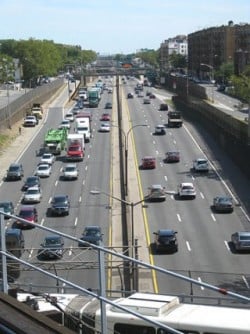More than seven months ago, I posted: “New L.A. freeway-adjacent homes getting air filtration as way to reduce indoor particles.” The post dealt with homes along Los Angeles, California-located freeways getting home particulate filters installed to filter out fine particulate matter from indoor air. Though, this applies only to new homes situated within 1,000 feet of an L.A.-area freeway.
A good idea or not?!

Regarding fine particulates, from studies, it has been determined fine and ultrafine particles don’t just enter the lungs when inhaled; they penetrate deep into lung tissue and can enter the bloodstream. Chemical traces tied to PM 2.5 have even been found in human urine samples. And, the sources are varied – everything from automotive exhaust to the burning of wood, whether naturally occurring through a lightning strike, for example, or logs set afire under controlled conditions in the fireplace.
With this in mind, when you consider why the filters were ordered, to me, this is recognition by local officials, home builders, residents and others of the damage to health fine particles (PM 2.5 – particles less than 2.5 micrometers across or about one-twentieth to one-thirtieth the width of a human hair) can cause when inhaled and the risk particles pose long-term.
Moreover, it’s also an admission that PM 2.5 to those living beside or near highly-trafficked corridors especially, presents a clear and immediate danger – not just one across many years as there is no level that is safe regarding PM 2.5 or for that matter, ultrafine particulate matter or particles less than 1 micrometer in size. This is just bad stuff – plain and simple.
Like I mentioned in the article above, I am curious to know how effective these filters are at trapping microscopic specks inside the home. Not just this but how often the filters need replacing, if they can be washed and reused or in doing the job of catching soot, if filters needing disposing of, what the form is this disposal will take. Will they be landfilled, burned, what?! Moreover, if only single use, where will such be made available for purchase and how much will they cost? And, what will be the cost to have said filtering systems installed?
So, one thought leading to the next, this has obvious implications for homes located not near freeways per sé, but anywhere PM 2.5 is problematic and persists.

I can’t help but wonder if any of the homes being outfitted with fine-particle-pollution traps, also have fireplaces, though in my making an educated guess, I would think not.
As mentioned earlier, in the Valley 70 percent of PM 2.5 emanates from transportation and other source activity. Californians are by-and-large a mobile lot. And, being said fine particulate matter pollution is also mobile, does this mean that motor vehicles operating in state should also be filter equipped? I mean, think about it. If new residences adjacent to L.A. freeways require the particle-trapping equipment, it would make sense that area vehicles should be so-equipped as well. Seems logical to me. And, provided these are effective, such would or should provide an extra measure of protection from harmful PM 2.5 to vehicle occupants (provided all windows are closed), or you would think. So, why limit the filters to home application only?
As it relates, I am reminded of the information in “HECA: Taking school-bus-interior air-cleaning to whole new level.”

“Developed by study researchers was a prototype HECA filtering system specially designed for inside-the-school-bus cabin use and not one but two were placed at the back of each of the half-dozen school buses under evaluation. ‘Air was drawn in through diffusers on the sides of each unit and fed through the HECA filter,’ Irwin wrote. ‘The filtered air was then delivered at a constant rate through air ducts.’
How did the filter perform?
“The ‘on-board air filtration system developed specifically for school buses reduces exposure to vehicular pollutants by up to 88 percent, according to a study by researchers at the UCLA Fielding School of Public Health,’ Irwin stated.”
HECA stands for “High Efficiency Cabin Air” in this case.
And, as for installation of particulate traps anywhere PM 2.5 is sourced?
Again, good idea or not?!
Image (bottom): David Rees, U.S. Environmental Protection Agency, held and cataloged by the U.S. National Archives and Records Administration
– Alan Kandel